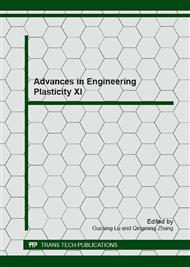p.147
p.152
p.156
p.160
p.164
p.168
p.173
p.177
p.181
Localized Necking in a Round Tensile Bar with HCP Material Considering Tension-Compression Asymmetry in Plastic Flow
Abstract:
In spite of this progress in predicting ductile failure, the development of macroscopic yield criteria for describing damage evolution in HCP (hexagonal close-packed) materials remains a challenge. HCP materials display strength differential effects (i.e., different behavior in tension versus compression) in the plastic response due to twinning. Cazacu and Stewart [1] developed an analytic yield criterion for a porous material containing randomly distributed spherical voids in an isotropic, incompressible matrix that displays tension-compression asymmetry. The matrix material was taken to obey the isotropic form of the Cazacu et al. [2] yield criterion, which captures the tension-compression asymmetry of the matrix material. In this paper, finite element calculations of a round tensile bar are conducted with the material behavior described by the Cazacu and Stewart [1] yield criterion. The goal of these calculations is to investigate the effect of the tension-compression asymmetry on the necking induced by void evolution and propagation.
Info:
Periodical:
Pages:
164-167
Citation:
Online since:
January 2013
Authors:
Price:
Сopyright:
© 2013 Trans Tech Publications Ltd. All Rights Reserved
Share:
Citation:


